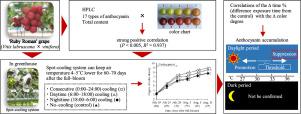Scientia Horticulturae ( IF 4.3 ) Pub Date : 2021-07-12 , DOI: 10.1016/j.scienta.2021.110381 Kenichi Matsuda 1, 2 , Mei Gao–Takai 3 , Ayaka Date 1 , Takashi Suzuki 2

|
The effect of high air temperature on the anthocyanin accumulation in the epicarp of 'Ruby Roman' grape (Vitis labruscana × vinifera) berries was examined. Seventeen types of anthocyanin were detected from the epicarp tissue of the matured berries using HPLC. Since a strong positive correlation (P < 0.005, R2 = 0.937) was confirmed between the degree of color density evaluated using a color chart and the total content of anthocyanins quantified separately, it seems possible to trace anthocyanin accumulation using the color chart on each berry during maturation at different air temperatures. Four conditions were designed for cooling the fruit clusters with a spot-cooling system, which can keep air temperature 4–5°C lower for 60–70 days after the full–bloom, i.e. consecutive (0:00–24:00) cooling, daytime (6:00–18:00) cooling, nighttime (18:00–6:00) cooling and no–cooling (control). The degree of color density showed statistically higher (P < 0.05) values in the consecutive–cooling treatment than that of the control through the post–cooling duration (0–15 days after cooling). To clarify the effect of temperature zones with or without daylight on the anthocyanin accumulation in the epicarp, percentage of exposure time to each temperature zone of < 21, 21–24, 24–27, 27–30, 30–33, 33–36 and 36°C ≤ were calculated for both daylight and dark periods, separately. Correlations of the ∆ time% (the amount of difference in percentage of exposure time from the control) with the ∆ color degree (the amount of difference in degree of color density from the control) in the daylight period were positive at temperature zones of < 30°C, but turned to negative at those of 30°C ≤. The fact that correlation coefficient was statistically significant (P < 0.05) at the temperature zones of 27–30°C (positive) and 33–36°C (negative) in the daylight period shows that the threshold where the anthocyanin accumulation starts to be suppressed exists within 30–33°C.
中文翻译:

抑制成熟期间白天气温高于 33°C的葡萄(Vitis labrusca × vinifera cv. Ruby Roman)浆果外果皮中与花青素积累相关的红色形成
检查了高温对'Ruby Roman'葡萄(Vitis labruscana × vinifera)浆果外果皮中花青素积累的影响。使用高效液相色谱法从成熟浆果的外果皮组织中检测到 17 种花青素。由于强正相关 ( P < 0.005, R 2 = 0.937) 在使用颜色图表评估的颜色密度程度与单独量化的花青素总含量之间得到证实,似乎可以使用颜色图表在不同气温下成熟过程中对每个浆果进行追踪花青素积累。采用点冷系统对果串进行冷却设计了四种条件,可在盛开后的 60-70 天内保持空气温度降低 4-5°C,即连续(0:00-24:00)冷却、白天 (6:00–18:00) 制冷、夜间 (18:00–6:00) 制冷和不制冷(控制)。颜色密度的程度在统计学上显示较高(P< 0.05) 在冷却后持续时间(冷却后 0-15 天)的连续冷却处理中的值比对照值。为了阐明有或没有日光的温度区对外果皮中花青素积累的影响,每个温度区的暴露时间百分比 < 21, 21–24, 24–27, 27–30, 30–33, 33–36和 36°C ≤ 分别计算白天和黑暗时期。Δ 时间%(与对照的曝光时间百分比差异量)与 Δ 色度(与对照的颜色密度程度的差异量)在日光期间的相关性在 < 30°C,但在 30°C ≤ 时转为负值。相关系数具有统计学意义(P < 0.05) 在白天 27-30°C(正)和 33-36°C(负)温区,表明花青素积累开始受到抑制的阈值存在于 30-33°C 内。



























 京公网安备 11010802027423号
京公网安备 11010802027423号